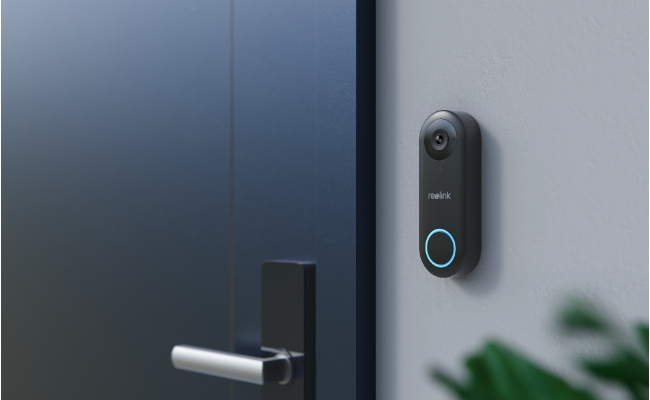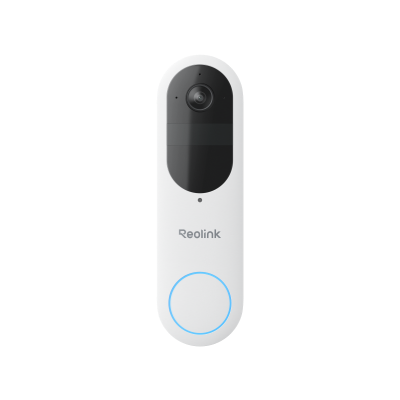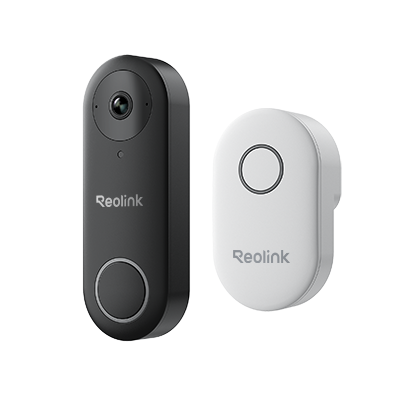Doorbell Power Supply: Top Things You Need to Know

Securing your home begins at the front door, and a doorbell camera is a valuable addition to your home security arsenal. However, to keep it functioning optimally, understanding the doorbell power supply is crucial.
In this article, we'll explore the top things you need to know about doorbell power supplies. From the basics of how they work to considerations for different types of doorbell cameras, we'll guide you through the essentials to ensure your doorbell is always powered and ready to safeguard your home.
Hardwired Power Supply for Doorbell
A doorbell using a plugging-in power supply is commonly found in WiFi or smart doorbell systems. The process involves linking the doorbell to a provided power adapter, which transforms standard household AC power into the required DC power for the doorbell's functionality. Subsequently, users simply plug the adapter into a standard electrical outlet. Now, let's know aboutits power supply voltage and adapter.
The common doorbell power supply voltage
Common doorbell power supplies typically operate at low voltages, with both AC (Alternating Current) and DC (Direct Current) options. Most doorbells run on low-voltage AC power, ranging from 12 to 24 volts, for safety and compatibility with residential settings. As for DC option, most doorbells run on 24 volts.
The suitable power supply adapter for doorbell
When you purchase a WiFi video doorbell from a trustworthy vendor, the package typically includes essentials like the doorbell, a chime, a power adapter, an Ethernet cable, and more. Take Reolink's WiFi Video Doorbell, for instance—it's a network-cable-free camera requiring a power adapter for functionality. These adapters, provided by reliable sources, generally have a lifespan of five years or more with regular use.
However, caution is necessary when dealing with poor-quality doorbell power adapters, as they may pose risks like fire hazards, melting issues, and damage to the video feed, leading to potential disappointment and compromised safety.
PoE Power Supply for Doorbell
A Power over Ethernet (PoE) doorbell streamlines your installation process, eliminating the need for separate electrical supply lines. With a single Ethernet cable, you can power up the doorbell, connect it to the network, and sidestep concerns about missing doorbell wires in your apartment or commercial property. The plug-and-play setup not only saves time but also simplifies maintenance with its straightforward wiring.
Unlike traditional doorbells, PoE doorbells operate without relying on WiFi, ensuring a stable connection, and they support high-speed data transmission through Ethernet cables. Achieving speeds of up to 1 Gbps via Cat5 and Cat6 cables, these doorbells often adhere to IEEE 802.3at or 802.3af standards. This not only results in reduced latency but also enhances the overall experience with smoother live video streaming and real-time communication.
Battery & Solar Power Supply for Doorbell
Another power for doorbell can be rechargeable battery and solar energy. These wireless doorbells operate on WiFi or ceullar networks, offering greater flexibility when you install them. You can place them in various locations without the constraints of wiring, adapting to your specific needs.
Operating on rechargeable batteries, such as lithium-ion or other high-capacity variants, these doorbells are designed for extended use. The batteries can be recharged using a power adapter or solar panels, eliminating the need for frequent replacements.
Comparison: Hardwired Power vs. PoE Power vs. Battery Power Doorbell
The comparison between DC power, Power over Ethernet (PoE), and battery power for doorbells involves trade-offs in installation, reliability, flexibility, maintenance, and sustainability.
DC power doorbells provide a continuous power supply but require professional installation and are less flexible in placement. PoE doorbells offer stable power and more flexibility than DC, but still involve cabling and professional installation. Battery-powered doorbells, operating on rechargeable batteries, offer easy wireless installation, high flexibility, and sustainability, but require periodic maintenance for recharging or battery replacement.
Here ia a comparison list:
Best Video Doorbell Recommendation
Considering the diverse preferences and needs in the realm of video doorbells, let's explore a few recommendations that cater to different priorities, ensuring there's an ideal choice for everyone.
Smart 2K Battery-Powered Video Doorbell with Chime - Reolink Battery Doorbell
Battery-powered doorbell cameras have become popular in the market thanks to their ease of use and exceptional flexibility. The new Reolink Battery Doorbell features a 2K head-to-toe view with advanced HDR technology. It includes AI functions for detecting people, vehicles, and packages. You can enjoy on-site storage with a MicroSD card of up to 256GB and the Reolink Home Hub. Plus, you can communicate with visitors at your front door using the built-in mic and speaker.
Smart 2K Dual-Band Wi-Fi Battery Doorbell
2K 4MP Head-to-Toe View; Person/Vehicle/Package Detection; Works with Reolink Home Hub & Wi-Fi NVR; 5/2.4GHz Dual-Band Wi-Fi.
Smart 2K+ WiFi video doorbell with chime - Reolink Video Doorbell WiFi
With its Smart 2K+ Wired WiFi design and integrated chime, Reolink Video Doorbell WiFi ensures a seamless and intelligent entrance experience. The 2K+ (5MP) HD video quality provides a crystal-clear view of your front door, enhancing both security and visual clarity. Its dual-band 2.4/5GHz WiFi support ensures a stable and responsive connection.
The addition of person detection further refines the monitoring capabilities, alerting you specifically to human activity. Plus, its compatibility with Reolink NVRs adds an extra layer of versatility, allowing for integration into a broader security system.
Smart 5MP Video Doorbell with Chime
5MP Super HD Day & Night, Person Detection, 2.4/5 GHz Dual-Band WiFi, 180° Diagonal Viewing Angle, Two-Way Audio, Rich Notification.
Smart 2K+ PoE video doorbell with chime - Reolink Video Doorbell PoE
Reolink Video Doorbell PoE is a Smart 2K+ PoE Video Doorbell featuring a chime. Boasting advanced video quality, audio capabilities, and intelligent features, this doorbell is tailored for your front door needs. Enjoy crystal-clear 2K+ Super HD video, capturing your front door in a wide 180° Field of View (FOV) with the added advantage of reviewing events 6 seconds before motion detection. The convenience continues with a seamless chime integration—simply plug it into any electrical socket, and you'll be alerted with a distinctive "knocking" sound from any room.
Smart 5MP Video Doorbell with Chime
5MP Super HD, Person Detection, Power over Ethernet, 180° Diagonal Viewing Angle, Two-Way Audio, High-Quality Night Vision.
How to Install a Doorbell?
Opting for a wireless doorbell is an excellent decision when your home lacks pre-existing doorbell wiring, and the installation process is notably straightforward. On the other hand, if you're considering a replacement for your current mechanical doorbell and have existing wiring in place, a wired doorbell is the ideal choice. Now, let's delve into the installation procedures for both options.
How to install wireless doorbell?
Installing a wireless smart doorbell offers the freedom to choose the perfect location without the constraints of wiring. Fully charge your doorbell’s battery before you mount it. Begin by selecting a suitable spot near your front door. Use a drill with a small bit to create pilot holes for the screws, and secure the mounting plate to the wall using the provided screws.
Once mounted, synchronize the button unit with your home's Wi-Fi router and your smartphone. This step varies by manufacturer but typically involves downloading and installing a dedicated app on your phone. This app enables you to remotely control and monitor the doorbell's features, providing you with the convenience of monitoring your doorbell from anywhere.
How to wire a doorbell?
- Press the current doorbell button to verify if the existing chime rings, ensuring the functionality of the old doorbell wiring. Once confirmed, power off the entire doorbell system.
- Remove the cover of the mechanical chime, and take a photograph of the current wire connections for future reference.
- Loosen the connector screws on the Trans and Front terminals of the mechanical chime. Be cautious not to remove the screws or existing wires.
- Connect the two spades of the provided jumper cable to the Trans and Front terminals. Ensure a secure connection by tightening the screws onto the terminals.
- Replace the old doorbell button with the new video doorbell to complete the installation.
FAQs
1. Can a doorbell work without a transformer?
In a wired doorbell system, a transformer is typically essential for the doorbell to function properly. The transformer reduces the higher voltage from your home's electrical system to a lower voltage that is suitable for the doorbell. Without a transformer, the doorbell may not receive the correct power supply, and its components could be at risk of damage.
However, there are exceptions. Some modern wireless doorbells operate on batteries and do not require a transformer. These battery-powered doorbells are designed for easy installation without the need for wiring and can function independently.
2. Why does my doorbell not have power?
If your doorbell lacks power, start by checking the transformer and circuit breaker panel for any issues. A faulty transformer or a tripped breaker could be the culprit. Inspect the wiring from the transformer to the doorbell, ensuring all connections are secure.
For battery-powered doorbells, replace the batteries if they're dead.
3. Can I install a doorbell without professional help?
Yes, many wireless and battery-powered doorbells are designed for easy DIY installation. However, if dealing with wired systems or facing technical issues, professional assistance may be advisable.
Conclusion
The power supply of your doorbell is a crucial consideration that directly impacts its functionality and installation. Whether you opt for the traditional reliability of wired doorbells with transformers, the convenience of battery-powered solutions, the innovation of solar-powered models, or the smart integration of various power sources, understanding your doorbell's power supply is key to ensuring a seamless and reliable home security system.
If you like this article and find it helpful, share it with your friends. Do you have something to say about power supply for doorbell? Make sure you leave a comment below!
Search
Be in the Know
Security insights & offers right into your inbox


